
Experiments with Neodymium Magnets
Text and Graphics Copyright © 2009 Henning Umland
Strong magnets, e. g., neodymium magnets, should be handled with care. They can erase data on all kinds of magnetic storage media (floppy disks, hard drives, credit cards, magnetic tapes, etc.) and disturb pace makers when getting too close. Moreover, they attract ferromagnetic objects, and particularly each other, so violently that there is always the risk of hurting oneself (pinched fingers or skin, etc.). Neodymium magnets are no toys for children!
Some time ago I purchased a couple of neodymium magnets (neodymium-iron-boron alloy) of various sizes. Since I wanted to observe weak effects, I chose magnets with one of the strongest magnetizations presently available (N52). The magnetic flux density at the surface (poles) of such a magnet exceeds 1 T (1 T = 1 Vs/m2). In comparison, the flux density of the earth's magnetic field is about 60 µT at the magnetic poles.
The following photo shows a stack of two cylindrical magnets. Each one has the dimensions D 50 mm × H 30 mm. The attraction forces between both magnets are so strong that it is virtually impossible to separate them from each other.
 |
Stack of 2 Neodymium Magnets
Experiments with Diamagnetism and Paramagnetism
In contrast to ferromagnetism, the effects of diamagnetism and paramagnetism are very weak and usually go unnoticed in everyday life. They become obvious, however, when exposing various materials to the strong field of a neodymium magnet. This is demonstrated by the following experiments. Because of their simplicity, they are particularly suitable for educational purposes (schools, etc.).
For the following demonstrations I used a test tube with a srew cap (a rubber stopper will work as well). First, I filled the tube almost completely with alcohol (ethanol, 92% grade) before sealing it. I left so much air in the tube that a bubble of approx. 3 or 4 cm length became visible when placing the tube flat on a table. Adjusting the tube perfectly horizontal requires some patience but can be managed with a stack of paper. Thus, the tube forms a very sensitive spirit level. The following video clip shows what happens when approaching the air bubble with the pole of a neodymium magnet (to start a video, click on the respective image).
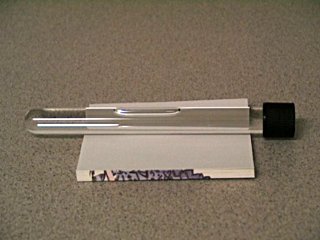 |
Test Tube with Ethanol
The magnet seems to attract the air bubble. In fact, the liquid is repelled by the magnet (causing the bubble to move in the opposite direction) since ethanol is diamagnetic (no unpaired electrons in the molecule). One might argue that the bubble is attracted because air contains oxygen which is paramagnetic. Therefore I repeated the experiment with a CO2 bubble without noticing any difference.
Ordinary spirit levels are also influenced by strong magnets but to a much lesser extent because their chamber holding the liquid is usually barrel-shaped.
The next video demonstrates what happens when using a test tube filled with a 25% solution of manganese (II) chloride tetrahydrate in ethanol.
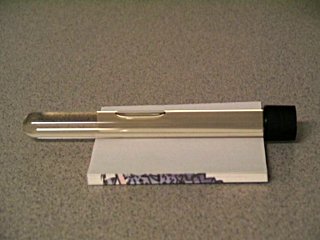 |
Test Tube with MnCl2 · 4 H2O in Ethanol
Now the magnet attracts the liquid. The effect is even more distinct than before. The hydrated Mn2+ ion is strongly paramagnetic since there are 5 unpaired electrons in the 3d shell (high-spin complex). The paramagnetism is so strong that it can overcompensate the diamagnetism of the solvent (depending on the concentration).
For the next experiment, I used a test tube containing less of the solution, about 2/3 of the total volume. The bubble extends almost from end to end now.
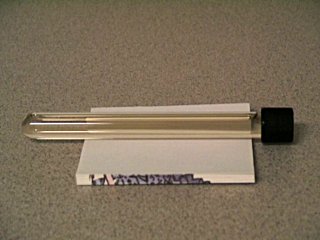 |
Test Tube with MnCl2 · 4 H2O in Ethanol (bigger air bubble)
The attraction force is so strong that the surface of the liquid assumes a convex shape below the magnet. If the magnet gets close enough, the liquid even touches the upper wall of the glass tube, dividing the bubble into two parts which recombine as soon as the magnet is removed.
The magnetic attraction is even strong enough to roll a small bottle with MnCl2 solution accross the table:
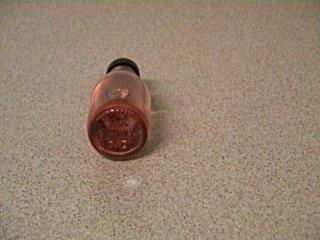 |
Small Bottle with MnCl2 Solution
Here the experiment is repeated with a sample tube containing pure MnCl2 · 4 H2O powder:
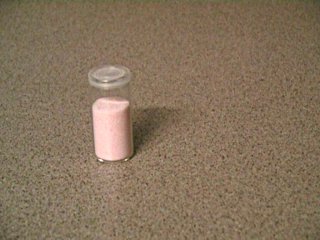 |
Glass Tube with MnCl2 · 4 H2O Powder
Will be continued...